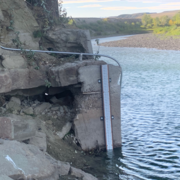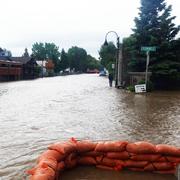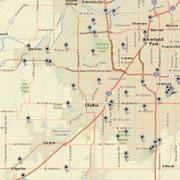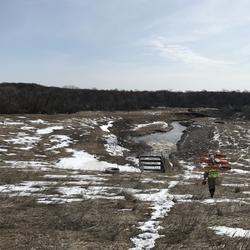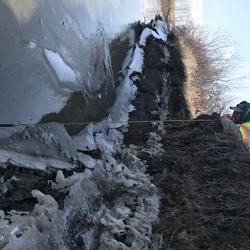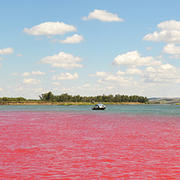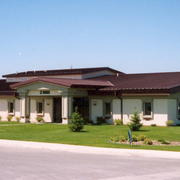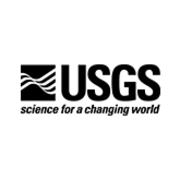Unified Interior Regions
Region 5: Missouri Basin

USGS Science Centers in the Missouri Basin Region
For more information on what each center is doing in the Missouri Basin, please follow the links below!
Wyoming - Montana Water Science Center
Northern Rocky Mountain Science Center
Regions L2 Landing Page Tabs
Welcome to Region 5! Our Region includes Montana, North Dakota, South Dakota, Nebraska, and Kansas. We conduct science to inform resource managers on issues such as invasive species, water quality/quantity, flood response, oil and gas, and restoration of fish/wildlife and their habitats.
Quantitative Disease Ecology
Researchers at the USGS are working on developing new quantitative methods to study disease dynamics in wildlife systems as well as systems at the wildlife-domestic-human interface. Much of our work focuses on how host population structure affects disease invasion, persistence and control in wildlife disease systems. We tackle these issues with a combination of simulation and statistical...
Hydrologic Assessment of the Blackfeet Reservation, Montana
The Blackfeet Nation seeks an increased scientific understanding of the water resources within the Blackfeet Reservation of northwestern Montana. Hydrologic information is needed in order to make informed water management decisions as the Blackfeet Nation moves forward with implementation of the Blackfeet Water Rights Compact as new water-use projects are initiated and as the Blackfeet...
Wyoming-Montana Stream Water-Quality Network - Water Year 2020
The USGS monitors stream water quality in Wyoming and Montana in cooperation with State, County, local, and other Federal agencies. Water-quality data for these sites are available from the USGS National Water Information System Web Mapper application in the form of an interactive map that can be accessed from the Data and Tools tab.
Eyes on Earth Episode 11 – EROS Fall Poster Session
Eyes on Earth is a podcast on remote sensing, Earth observation, land change and science, brought to you by the USGS Earth Resources Observation and Science (EROS) Center. In this episode, we hear from a few of the scientists on hand for the EROS Fall Poster Session.
Eyes on Earth Episode 4 - Cataloging Earth Observation Satellites
Eyes on Earth is a podcast on remote sensing, Earth observation, land change and science, brought to you by the USGS Earth Resources Observation and Science (EROS) Center. In this episode, we learn about the ever-expanding number of Earth observation satellites.
Peak-Flow Frequency Analysis for Selected Montana Streamgages
The Montana Department of Resources and Conservation requires peak-flow information for Federal Emergency Management Agency (FEMA) floodplain mapping for various locations across Montana. Accordingly, the USGS WY-MT Water Science Center has updated peak-flow frequencies for selected streamgages in the Beaverhead River, Clark Fork, Ruby, Jefferson and Madison River Basins, and for selected...
Eyes on Earth Episode 3 - National Land Cover Database
Eyes on Earth is a podcast on remote sensing, Earth observation, land change and science, brought to you by the USGS Earth Resources Observation and Science (EROS) Center. In this episode, we talk about the National Land Cover Database.
Eyes on Earth Episode 2 - Chernobyl
Eyes on Earth is a podcast on remote sensing, Earth observation, land change and science, brought to you by the USGS Earth Resources Observation and Science (EROS) Center. In this episode, we talk about the Chernobyl disaster.
Eyes on Earth Episode 1 - Intro to EROS
Eyes on Earth is a podcast on remote sensing, Earth observation, land change and science, brought to you by the USGS Earth Resources Observation and Science (EROS) Center. In this episode, we learn about EROS history and purpose.
Eyes on Earth
Eyes on Earth is a podcast on remote sensing, Earth observation, land change and science, brought to you by the USGS Earth Resources Observation and Science (EROS) Center. In this episode, we learn how a Collections strategy boost the value of the Landsat archive.
Flaxville Aquifer
The Flaxville aquifer is present in the northern and central parts of the Fort Peck Indian Reservation and consists of sand and gravel that forms extensive plateaus and topographic benches used for dryland farming. Because many residents rely on groundwater as their primary water supply on the Reservation, the Flaxville and underlying aquifers are important sources of groundwater. The goal...
Using Robots in the River: Biosurveillance at USGS streamgages
For more than a decade, researchers around the world have shown that sampling a water body and analyzing for DNA (a method known as eDNA) is an effective method to detect an organism in the water. The challenge is that finding organisms that are not very abundant requires a lot of samples to locate this needle in a haystack. Enter the "lab in a can", the water quality sampling and processing...
Surface water sites associated with the hydrologic assessment of the Blackfeet Reservation, Montana
Surface water sites associated with the hydrologic assessment of the Blackfeet Reservation in Montana.
Data for assessing the susceptibility of groundwater used for drinking water supply from selected principal aquifers of the Western United States, 2004-2018
Groundwater age distribution and susceptibility to natural and anthropogenic contaminants were assessed for selected principal aquifers of the Western United States: the Central Valley aquifer system (CVAL), the Basin and Range basin-fill aquifers (BNRF), the Rio Grande aquifer system (RIOG), the High Plains aquifer (HPAQ), the Columbia Plateau basaltic-rock aquifers (
Stillwater Complex Rock Outcrop Database
This dataset includes polygons that describe areas of rock outcrop in the area of the Stillwater Complex, Montana. The Stillwater Complex is an Archean, ultramafic to mafic layered intrusion exposed in the Beartooth Mountains in south-central Montana. This igneous intrusion contains magmatic mineralization that is variably enriched in strategic and critical commodities such as chromium, nic...
Geodetic Data for USGS Benchmark Glaciers: Orthophotos, Digital Elevation Models, and Glacier Boundaries
Since the late 1950s, the USGS has maintained a long-term glacier mass-balance program at three North American glaciers. Measurements began on South Cascade Glacier, WA in 1958, expanding to Gulkana and Wolverine glaciers, AK in 1966, and later Sperry Glacier, MT in 2005. Additional measurements have been made on Lemon Creek Glacier, AK to compliment data collected by the Juneau Ice
High Altitude Weather Station Data at USGS Benchmark Glaciers
Since the late 1950s, the USGS has maintained a long-term glacier mass-balance program at three North American glaciers. Measurements began on South Cascade Glacier, WA in 1958, expanding to Gulkana and Wolverine glaciers, AK in 1966, and later Sperry Glacier, MT in 2005. Additional measurements have been made on Lemon Creek Glacier, AK to compliment data collected by the Juneau Ice
Crustal Architecture Beneath the Southern Midcontinent (USA) -- Data Grids and 3D Geophysical Models
Regional grid files and 3D voxel models were used to study crustal architecture beneath the Southern Midcontinent (USA) by McCafferty and others (2019). The study covered a rectangular, multi-state area of 924 by 924 kilometers centered on Missouri, and a corresponding volume extending from the topographic surface to a depth of 50 kilometers below sea level. The grid files consist of
Tellurium Deposits in the United States
This data release provides the description of U.S. sites that include mineral regions, mines and mineral occurrences (deposits) that have a contained resource and (or) production of tellurium metal greater than 1 metric ton. For this data release, only one deposit in the U.S. with historic production records was found: Butte, Montana. We did not locate any deposits in the U.S. tha
Flood Event Viewer - Montana June 2018 Flood Rocky Mountain Front
The USGS WY-MT Water Science Center provided discharge measurements and high water mark (HWM) flagging for the June 2018 flooding along Elk Creek in Augusta, Montana.
Downloadable Data for National Oil and Gas Assessments
GIS Data for the National Oil and Gas Assessments
National Water Information System (NWIS) Mapper
The NWIS mapper provides access to over 1.5 million sites contained in the USGS National Water Information System (NWIS), including sites where current and historical surface-water, groundwater, springs, and atmospheric data has been collected. Users can search by site type, data type, site number, or place.
Airborne electromagnetic and magnetic survey data, Stillwater Complex, Montana, May 2000
A helicopter-borne electromagnetic/magnetic survey was flown over the Stillwater area, southwest Montana from May 5 to May 16, 2000. The survey was conducted over the Stillwater Igneous Complex, a Precambrian layered mafic-ultramafic intrusion which is characterized by igneous layering. Electromagnetic data were acquired using DIGHEM helicopter-borne electromagnetic system. Magnetic data
Downloadable Data for Forest City Basin Oil and Gas Assessments
GIS Data for Forest City Basin Oil and Gas Assessments
This map shows the provinces assessed by the USGS for undiscovered oil and gas resources.
StreamStats is a Web-based geographic information system application that was created by the USGS to provide users with access to an assortment of analytical tools that are useful for water-resource planning and management.
Quaternary geologic map of the Dakotas 4° x 6° degree quadrangle, United States - This digital dataset is available for the Quaternary geology in North and South Dakota
Digital map of aquifer boundary for the High Plains aquifer in parts of Colorado, Kansas, Nebraska, New Mexico, Oklahoma, South Dakota, Texas, and Wyoming - This digital data set represents the extent of the High Plains aquifer in the central United States
Map of sites around Kansas.
An interactive map of Johnson County with sites.
This map shows the location of stream gages where the water level is currently at or above flood stage (depicted as a black triangle) or at high flow (depicted as blue circles) The high flow conditions are expressed as percentiles that compare the current (i.e., within the past several hours) instantaneous flow value to historical daily mean flow values
Study area for the Kansas River Algal project.
The purpose of the study is to assess the effects of wastewater discharge and treatment facility upgrades on the environmental and biological conditions of Indian Creek, downstream from the Middle Basin wastewater treatment facility (WWTF).
Equus Site Map has various wells and recharge points in the Equus study area to promote water recharge.
The 3DEP products and services available through The National Map consist of standard digital elevation models (DEMs) at various horizontal resolutions, elevation source and associated datasets, an elevation point query service and bulk point query service. All 3DEP products are available, free of charge and without use restrictions.
This mapper displays SPARROW nutrient load and yield data and the importance of various nutrient sources for the RARB, given nutrient inputs similar to 2002. Rankings can be shown by country, state/province, HUC4, HUC8, and catchment. Nutrient data can be explored using maps and interactive graphs and tables. Modeling results can be exported as an Excel spreadsheet or a geospatial dataset.
Comet NEOWISE and the Roosevelt Arch at Yellowstone National Park
Comet NEOWISE is seen with the Roosevelt Arch in the foreground at the north Entrance of Yellowstone National Park. The town of Gardiner, Montana, is in the background.
Dragonfly Mercury Project specimen collection in Glacier NP
Researchers instruct volunteers on how to collect dragonfly larvae in Glacier NP as a part of the Dragonfly Mercury Project.
USGS Responds to Spring Flooding in Minnesota
On April 10, USGS hydrographer Josh Sundberg measures Red River water flowing over the road in East Grand Forks, Minnesota as flood protection walls prevent further flooding.
USGS Responds to Spring Flooding in North Dakota
On April 6, USGS hydrographer Spencer Wheeling carries equipment out to measure high water on the Tongue River near Akra, North Dakota.
The USGS Dakota Water Science Center began their spring flood response on March 9, 2020, when melting snow caused river levels to exceed flood stage at sixteen USGS streamgage locations in eastern South Dakota. At the height of
...USGS Responds to Spring Flooding in North Dakota
USGS hydrographer Chris Broz gets on the cold ground to measure the high-water mark of the Pembina River at Neche, North Dakota.
The USGS Dakota Water Science Center began their spring flood response on March 9, 2020, when melting snow caused river levels to exceed flood stage at sixteen USGS streamgage locations in eastern South Dakota. At the height of operations
USGS Responds to Spring Flooding in North Dakota
USGS hydrographer Spencer Wheeling gets equipment ready to collect a flood water-quality sample on the Wild Rice River near St. Benedict, North Dakota. Collecting water-quality samples helps communities assess the sources and fate of contaminants in aquatic systems, to protect and enhance water resources for human health, aquatic health and environmental quality.
The
USGS Responds to Spring Flooding in North Dakota
USGS hydrographer Brent Hanson wades out in freezing waters to collect flood measurements on the Sheyenne River near Cooperstown, North Dakota. Hanson reads an outside staff, which is a vertical graduated ruler used to calibrate the continuous readings of water level provided by electronic sensors. Water level is important information for communities living adjacent to
...USGS Responds to Spring Flooding in North Dakota
A frozen USGS rapid deployment streamgage measures the height of the Maple River near Page, North Dakota. RDGs can be installed on short notice to provide additional information at locations that are normally not gauged.
The USGS Dakota Water Science Center began their spring flood response on March 9, 2020, when melting snow caused river levels to exceed flood stage
Map showing ice cover in the Yellowstone region
Map showing ice cover in the Yellowstone region. Light shaded areas bounded by black and red lines indicate areas covered during the Pinedale (about 20,000-15,000 years ago) and Bull Lake (about 150,000 years ago) glaciations, respectively. Blue lines are contours in thousands of feet on the maximum reconstructed Pinedale glacier surface. The circled numbers schematically
...Yellowstone Volcano Observatory Monthly Update: December 2, 2019
Mike Poland, Scientist-in-Charge of the Yellowstone Volcano Observatory, describes activity at Yellowstone during the month of November 2019.
Eyes on Earth Episode 11 - EROS Fall Poster Session
Each fall, EROS invites its staff scientists and area graduate students to visit for a noontime poster session. The poster sessions offer a change for those researchers to present their results to their peers and get feedback from their fellow scientists. For this episode, we’ll hear about research into biofuels, cloud-friendly Landsat data, shrubland mapping and satellite
Yellowstone Volcano Observatory Monthly Update: November 1, 2019
Mike Poland, Scientist-in-Charge of the Yellowstone Volcano Observatory, describes activity at Yellowstone during the month of October 2019
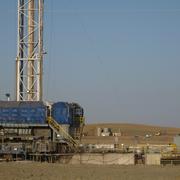
A new USGS study reports that shale-oil and -gas production from a major production area in Montana, North Dakota, and South Dakota has not caused widespread hydrocarbon contamination to date in nearby aquifer zones used for drinking-water supply.
A total of $135,000 will fund new research and preserve important data across the Show Me State
The scarcity or overabundance of water presents some of the most dangerous, damaging and costly threats to human life, ecosystems and property in the form of drought, floods and debris flows.
U.S. Geological Survey and partners will inject a harmless, bright red fluorescent dye into the Kansas River on September 29, weather permitting. The study is being done by the USGS in cooperation with the Kansas Water Office, Kansas Department of Health and Environment, The Nature Conservancy, City of Manhattan, City of Topeka, City of Olathe and WaterOne.
Many bumble bee species have declined in recent decades due to changes in habitat, climate, and pressures from pathogens, pesticides and introduced species. The western bumble bee, once common throughout western North America, is a species of concern and is being considered for listing by the U.S. Fish and Wildlife Service under the Endangered Species Act.
U.S. Geological Survey field crews are measuring flooding across the country as spring weather is in full swing. Warming temperatures, increased precipitation and snowmelt have caused moderate to major flooding in the upper Midwest, East Coast, Central Plains and the Southeast portions of the country.
Budget Focuses on Bringing Science, Facilities, and Infrastructure into the 21st Century

Reducing delivery of nitrate to the Gulf of Mexico is critical to decreasing the size of the “dead zone”—an area of hypoxia, or low dissolved oxygen—in Louisiana coastal waters. A new USGS study reports that larger, more widespread decreases in nitrate loading to the Gulf are needed to achieve the target levels of a 25% reduction by 2025.
Study Shows Water Quality Minimally Affected by Artificial Recharge
Do you eat fruits and vegetables? What about nuts? If so, you can thank an insect pollinator, usually a honey bee. These small insects play a major role in pollinating the world’s plants, including those we eat regularly. They also increase our nation’s crop values each year by more than 15 billion dollars.
News media and the public are invited to a free meeting about critical South Dakota-area water issues on Thursday, April 11, in Rapid City, South Dakota.
Reporters: Do you want to interview USGS scientists as they measure flooding in and near Fargo, North Dakota? Please contact Dave Ozman, Marisa Lubeck or Chris Laveau.





